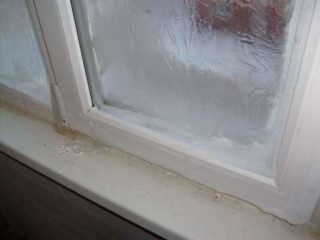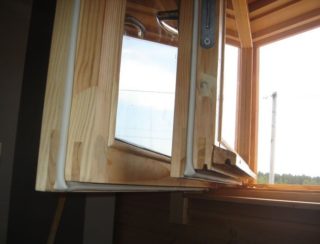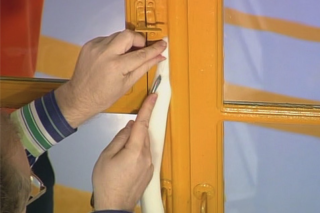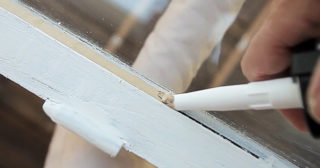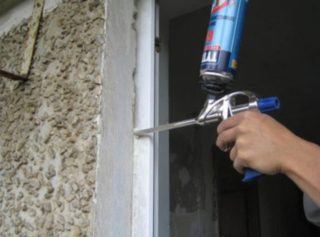One of the minuses of a wooden window is cracks and cracks through which cold air enters the house. It’s easy to get rid of. Warming of wooden windows is carried out in a variety of ways, both outside and inside.
Signs of the need for insulation of wooden windows
A wooden window, especially an old one, does not form the degree of tightness that a plastic one implies. This is not a design flaw, but its feature: a wooden frame always passes more air due to gaps between the elements and the structure of the wood itself. If the room has wooden windows, you don’t have to worry about ventilation, excess moisture leaves the room naturally.
However, over time, the tree dries up and cracks. The frame changes its configuration: between the wings, between the frame and the wall, between the wooden elements and the glass, “extra” gaps appear. Visually, the window does not change, but finding gaps is not so difficult.
A clear sign that it is time to insulate the windows is an increase in heating costs, at the same outside temperature and the same rate. Part of the warm air exits through unintended gaps. The inhabitants of the apartment, trying to maintain a comfortable temperature, drown more intensively and spend more.
Slots can be detected directly: just bring a wet hand to the sash. If a weak air flow is felt - the frame is leaking.
An even more obvious sign is the appearance of frosty patterns on the glass.
You can detect leaks in the summer. A lit candle is placed opposite the suspicious area. If the flame deviates, it is necessary to insulate the windows. It is better to do this until the moment when the air temperature drops below +5 C.
Window preparation
Before warming the window, it is prepared. Frame and glass are washed, dried and treated with some degreasing agent.
The wooden structure is examined by any of the above methods to determine where the cold passes into the room. Most often these are slopes, windowsill, places of closing of the frame and sash. A cold bridge appears between the glass and the sash frame. If the tree is very dry, frosty air also passes through deep cracks.
The window sill, the ebb and the slopes are closed from the outside, the sashes and the frame - from the inside.
The best ways to warm
A wooden window is insulated with sealant, paper, gaskets, mounting foam. How to insulate windows, choose based on the number of detected cracks, the condition of the tree and the required degree of insulation. You can make wooden windows as tight as plastic.
Newspaper and paper
A cheap, and sometimes even free, method of sealing cracks in a wooden window. Choose one of the options:
- The paper is better white, but not loose, not for the printer, cut into strips 4–5 cm wide. A soap solution or paste is prepared, the strips are greased with an adhesive and glued along the joint of the sash, frame and wall. The same result provides masking tape. In spring, the glued strips are soaked and removed.
- If the slots are too wide, they act differently. Newspapers and paper moisturize, fold into tubes and fill them with voids.
- To close up thin cracks in a dry tree, paper or newspaper is torn into small fragments, soaked to a mushy state and covered with cracks. Warming is not removed in the spring.
- To seal thin slots, another option is also used. Small newspaper scraps are mixed with a glass of flour and diluted with water to the state of sour cream. The composition is covered with the thinnest cracks that cannot be repaired. The mixture can also close the gaps between the frame and the wall, for example.
Paper pasting guarantees a high degree of tightness. To ventilate the room, it is necessary to open the window.
Cotton wool, cloth and scotch tape
Slots and gaps are covered with technical cotton wool: they push the material with tweezers, a point of scissors, or another sharp object. Then, cotton fabric is cut into strips 4–5 cm wide, moistened with soapy water, slightly squeezed out and taped with gaps and gaps filled with cotton. The fabric is selected monochromatic, otherwise the window looks messy.
You can seal the gaps with masking tape, and instead of cotton wool use a linen cord. The method is more practical. The fabric does not turn yellow like paper, and it is much easier to move away from the frame. Cotton from the slots is also much easier to remove.
Foam rubber
Foam tape - insulation and lightweight material. She has a short shelf life of 2 years, but the material is cheap. Foam rubber does not deform when compressed, so the insulated windows can be opened.
Foam rubber is cut in length, remove the protective strip and fill them with voids or stick at the place of joining. If the gap is too deep, lay a few strips.
The width of the compressed foam strip should be equal to the width of the gap.
Paraffin or Sealant
To make a wooden window leakproof, you can use silicone sealant or paraffin.
For insulation, a moisture-resistant composition with antifungal properties is taken. Usually it is a polyurethane or theokol sealant. Silicone is squeezed out using a nozzle and filled with voids of any kind. The surface is immediately rubbed to distribute the sealant in an even layer and remove excess. Hardened material is extremely difficult to remove. The result is preserved for several years, and the shutters closed with sealant cannot be opened.
Another way is molten paraffin. The substance is drawn into a syringe and filled with a gap. Paraffin provides the same degree of tightness, but is easily removed.
Popular swedish technology

Insulation of windows using Swedish technology is an effective method, but also a difficult one. For old windows, it is not suitable, since it involves dismantling the product and drilling grooves. Such thermal insulation is valid for 15–20 years.
- Remove the sash. The window is washed, dried, degreased.
- In the window frame, in the frames of the sash and window leaf, a groove is cut out with a milling cutter. The dimensions and configuration of the groove coincide with the shape of the selected insulation: polyurethane, PVC, foam. No glue is needed, as the sealant is held due to thickenings.
- The joints between the frame and the glass are filled with silicone sealant.
- Set the sash in place.
Insulation of wooden windows, made by Swedish technology, does not affect the appearance of the structure, the sash and window leaf can be opened at any moment. Such thermal insulation improves the sound insulation of windows.
Window opening insulation
When cracks appear between the window block and the slopes or window sill, foam rubber or gaskets are used for small voids, but there is an option that is more convenient - foam.
Foam increases in volume, filling in gaps of any size and shape.It freezes during the day and provides thermal insulation due to air bubbles contained in it. The composition is destroyed by sunlight. Staining or varnishing filled voids is a prerequisite.
Window openings need to be insulated from the outside and from the inside. Foam is the most convenient option.
Features of insulation of windows in a wooden house
A tree under the influence of heat, moisture, changes over time in volume. To prevent these changes from affecting the window, it is inserted into a floating frame - a casing from the same tree. The joints between the casing and the wall are sealed with jute or flax.
Between the window block and the casing, gaps also form over time. To seal them, use seals made of rubber, polyurethane, PVC. For internal thermal insulation it is allowed to use foam rubber, tubular seals.
In a wooden house, complete tightness of the window cannot be achieved. Moreover, this is undesirable, since such a vapor-tight “inclusion” violates the natural regulation of the microclimate.

